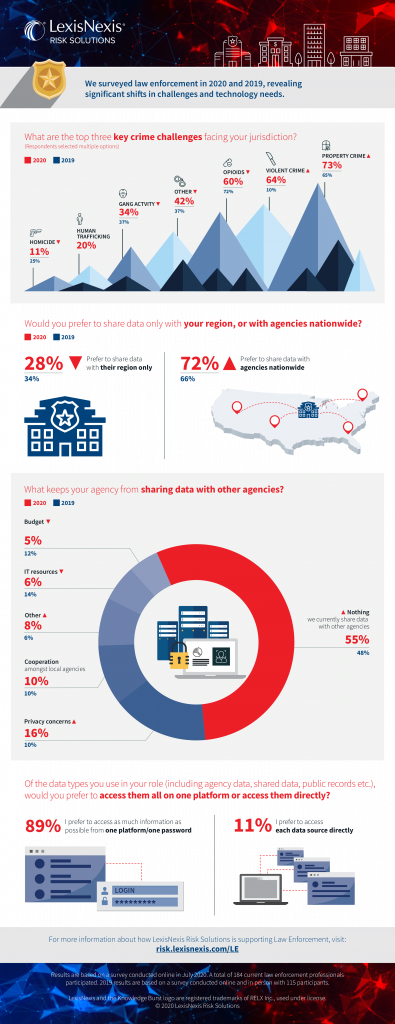It probably comes as no surprise to anyone that lockdown orders and shifts in activities due to the COVID-19 pandemic in the United States are impacting crime rates around the country. But a closer look at data provides details on how criminal activity has changed during these extraordinary times.
 The second annual Law Enforcement Technology Insight Survey found that authorities are dealing with dramatically increased challenges due to violent crime. The survey, conducted in July and August 2020, explored the daily challenges and data needs of all levels of federal, state, and local law enforcement across the United States. It revealed that a startling 64 percent of law enforcement point to violent crime as a top challenge today, up from a mere 10 percent in 2019.
The second annual Law Enforcement Technology Insight Survey found that authorities are dealing with dramatically increased challenges due to violent crime. The survey, conducted in July and August 2020, explored the daily challenges and data needs of all levels of federal, state, and local law enforcement across the United States. It revealed that a startling 64 percent of law enforcement point to violent crime as a top challenge today, up from a mere 10 percent in 2019.
In fact, last year, the law enforcement surveyed ranked violent crime as one of their lowest challenges; in 2020, it is considered the second most significant challenge. The shift in violent crime patterns makes sense as mass unemployment caused by the pandemic and hardships due to the virus have pushed many individuals to desperate measures and temperaments are at a breaking point. As the data show, violent crime has become a focus in jurisdictions across the United States.
The survey also found that 73 percent of respondents said that property crime was among their top three challenges, up from 65 percent in 2019. Opioids, which 72 percent of respondents identified as a top three challenge in 2019, dropped to 60 percent in 2020. Concerns about homicide dropped from 25 percent to 11 percent, and gang activity as a top priority was also down slightly from 37 percent to 34 percent. Although incidents of these crime types may be increasing or decreasing depending on jurisdiction, the survey shows how the unprecedented nature of 2020 has impacted the priorities of U.S. law enforcement.
Information Sharing Increasing
While crime patterns have changed amid the pandemic, what also emerged from the survey is the clear desire of law enforcement to share data from their day-to-day observations with other agencies. It is critical for agencies to have visibility into trends in other jurisdictions in order to effectively predict, prevent, and solve crimes.
It has become clear that law enforcement agencies want to work together on data sharing. The survey found that 72 percent of law enforcement would prefer to see and share data across the United States as opposed to just regionally. That statistic is up from 66 percent in 2019.
It is critical for agencies to have visibility into trends in other jurisdictions. . . . It has become clear that law enforcement agencies want to work together on data sharing.
The growing percentage of law enforcement who prefer to see and share agency data nationwide highlights the importance of arming law enforcement leaders with data solutions that allow them to do just that.
With that being said, there are barriers to data sharing that continue to hinder law enforcement efforts to truly collaborate on pinpointing important trends. When asked about those issues, 16 percent of survey respondents cited privacy concerns as a factor that is getting in the way of sharing with other agencies, up from just 10 percent the year prior. Other factors that were cited as hindering data sharing include budget (5 percent), IT resources (6 percent), and cooperation among local agencies (10 percent)
Overcoming the Obstacles
One answer to the issue of encouraging more data sharing is to equip agencies with solutions that are easy to use and deploy and can be thoroughly trusted in an age where protecting sensitive data and privacy is paramount. In fact, when asked, an astounding 88 percent noted a preference for accessing as much information as possible from one platform with one password. The message is clear: simplicity, ease of use, and trust are crucial for law officials who need to access data.
The challenges due to the pandemic are unfortunately far from over. Criminal patterns will continue to evolve and change. A platform for agencies to share their data with each other can help local agencies make the most informed decisions for their own communities and move forward intelligently and safely into the future.



